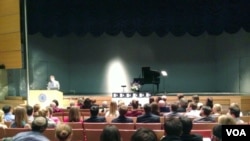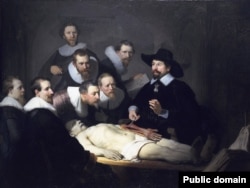NEW YORK —
Since the dawn of modern medicine in the 16th century, people studying to become physicians have dissected human cadavers as a hands-on way of learning the intricacies of anatomy.
Given the heavy scientific focus of these dissections, the humanity of the deceased is sometimes overlooked.
Gift of knowledge
For 40 years, medical and dental students and their anatomy professors at New York’s Columbia University College of Physicians and Surgeons have tried to correct this imbalance with a gratitude ceremony honoring the gift of knowledge contributed by body donors.
First-year medical and dental school students and their professors gather with the families and friends of people who donated their bodies to the school for dissection.
During their clinical gross anatomy course, Zachary Feldman and the other doctors-in-training spent long hours revealing and examining the organs, muscles, nerves and bones of the cadavers they’d been given.
“It’s nice to have a ceremony to acknowledge the large context and to see the real story and the human story outside the physical body, to sort of corroborate your data in the lab with real relatives and real people who loved that individual," Feldman said. "It puts you in touch with your own humanity.”
Paying tribute
Loved ones filed past a flower-covered table set with a row of urns containing the body donors' ashes. One by one, they stepped up to a podium to pay tribute and say goodbye.
"My mother felt that the greatest gift was to contribute to the education of others and always expressed that she wanted her body donated to research," said the daughter of one donor. "By being here today, we know that her greatest gift and wish has been fulfilled.
The wife of another donor ended her remarks with a poem: "For 58 years I was his wife, through days of happiness and times of strife. I am gratified now for his body and soul donation. To aid and assist Columbia’s new generation. I hope you benefit from his demise, to learn at a level making all more wise."
Even with online resources and 3D computer rendering, the medical knowledge gained from hands-on dissection can't be acquired any other way, according to Paulette Bernd, who designed and oversees Columbia’s clinical gross anatomy course.
“There is manual dexterity involved in terms of learning to use the equipment that they will eventually be using in surgery as well," Bernd said. "There is also the idea that they are using for the first time, working in a situation where they don’t know that what they find is going to look like the textbook… and they need to be able to interpret what they are seeing.”
First cut
For many, making that first cut into a human corpse can be hard. Elizabeth Shy's cutting and dissection technique was tentative at first, simply because it is a normal human instinct not to hurt someone.
"Even though you have a scalpel in your hand, you know your job is to cut into the body, it’s hard to really put enough pressure to make that happen," Shy said. "I found myself, through many, many labs, I’d just be holding the cadaver’s hand, and would find myself sort of rubbing the arm or the shoulder. It was my human reaction to try to comfort the patient. Even if the patient is not alive, they’re still sharing themselves with you and their illness and their body. It helps you learn how to form that connection with people.”
According to Feldman, who plans to specialize in psychiatry, medical students often report dreams in which they dissect a cadaver that suddenly comes alive and has the dreamer’s own face.
“I interpret that as, when you start medical school, your boundary between physician and patient is really blurred," he said. "When you see somebody else who is hurting or ill, it’s hard not to see your mortality and your own vulnerability and almost come to experience that pain with the patient, or in this case, with the cadaver."
Invaluable gift
Fellow medical student David Hankins finds it impossible to overstate the value of the body donors' gift.
“Because if you think about how many students there are who took the clinical gross anatomy course just this year and how long they are going to be practicing and how many people we are going to see every day of our careers, we have millions of chances to make a difference in someone’s life," Hankins said. "And that really is going to be possible only because of our strong understanding of the fundamentals of anatomy. And we absolutely couldn’t have gotten that without the benefit of the donors, and the tremendously courageous decision they made.”
Once rare, medical school gratitude ceremonies like the one at Columbia University’s College of Physicians and Surgeons are becoming widespread throughout the United States.
As one student put it, the anatomy course cadaver is really a future physician's “first patient,” and it’s best to begin how you intend to proceed.
Given the heavy scientific focus of these dissections, the humanity of the deceased is sometimes overlooked.
Gift of knowledge
For 40 years, medical and dental students and their anatomy professors at New York’s Columbia University College of Physicians and Surgeons have tried to correct this imbalance with a gratitude ceremony honoring the gift of knowledge contributed by body donors.
First-year medical and dental school students and their professors gather with the families and friends of people who donated their bodies to the school for dissection.
During their clinical gross anatomy course, Zachary Feldman and the other doctors-in-training spent long hours revealing and examining the organs, muscles, nerves and bones of the cadavers they’d been given.
“It’s nice to have a ceremony to acknowledge the large context and to see the real story and the human story outside the physical body, to sort of corroborate your data in the lab with real relatives and real people who loved that individual," Feldman said. "It puts you in touch with your own humanity.”
Paying tribute
Loved ones filed past a flower-covered table set with a row of urns containing the body donors' ashes. One by one, they stepped up to a podium to pay tribute and say goodbye.
"My mother felt that the greatest gift was to contribute to the education of others and always expressed that she wanted her body donated to research," said the daughter of one donor. "By being here today, we know that her greatest gift and wish has been fulfilled.
The wife of another donor ended her remarks with a poem: "For 58 years I was his wife, through days of happiness and times of strife. I am gratified now for his body and soul donation. To aid and assist Columbia’s new generation. I hope you benefit from his demise, to learn at a level making all more wise."
Even with online resources and 3D computer rendering, the medical knowledge gained from hands-on dissection can't be acquired any other way, according to Paulette Bernd, who designed and oversees Columbia’s clinical gross anatomy course.
“There is manual dexterity involved in terms of learning to use the equipment that they will eventually be using in surgery as well," Bernd said. "There is also the idea that they are using for the first time, working in a situation where they don’t know that what they find is going to look like the textbook… and they need to be able to interpret what they are seeing.”
First cut
For many, making that first cut into a human corpse can be hard. Elizabeth Shy's cutting and dissection technique was tentative at first, simply because it is a normal human instinct not to hurt someone.
"Even though you have a scalpel in your hand, you know your job is to cut into the body, it’s hard to really put enough pressure to make that happen," Shy said. "I found myself, through many, many labs, I’d just be holding the cadaver’s hand, and would find myself sort of rubbing the arm or the shoulder. It was my human reaction to try to comfort the patient. Even if the patient is not alive, they’re still sharing themselves with you and their illness and their body. It helps you learn how to form that connection with people.”
According to Feldman, who plans to specialize in psychiatry, medical students often report dreams in which they dissect a cadaver that suddenly comes alive and has the dreamer’s own face.
“I interpret that as, when you start medical school, your boundary between physician and patient is really blurred," he said. "When you see somebody else who is hurting or ill, it’s hard not to see your mortality and your own vulnerability and almost come to experience that pain with the patient, or in this case, with the cadaver."
Invaluable gift
Fellow medical student David Hankins finds it impossible to overstate the value of the body donors' gift.
“Because if you think about how many students there are who took the clinical gross anatomy course just this year and how long they are going to be practicing and how many people we are going to see every day of our careers, we have millions of chances to make a difference in someone’s life," Hankins said. "And that really is going to be possible only because of our strong understanding of the fundamentals of anatomy. And we absolutely couldn’t have gotten that without the benefit of the donors, and the tremendously courageous decision they made.”
Once rare, medical school gratitude ceremonies like the one at Columbia University’s College of Physicians and Surgeons are becoming widespread throughout the United States.
As one student put it, the anatomy course cadaver is really a future physician's “first patient,” and it’s best to begin how you intend to proceed.








